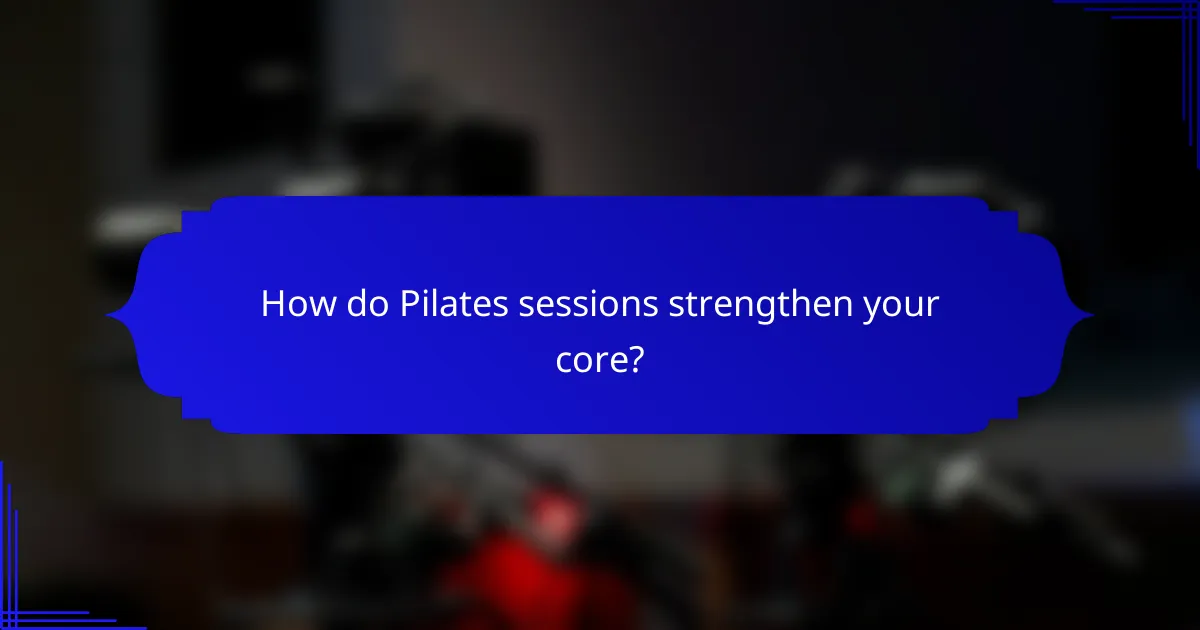Pilates sessions are designed to strengthen your core through controlled movements that engage deep abdominal muscles, enhancing stability and body alignment. This low-impact exercise method not only builds core strength but also plays a crucial role in injury prevention by promoting flexibility and overall body awareness.

How do Pilates sessions strengthen your core?
Pilates sessions strengthen your core by focusing on controlled movements that engage the deep abdominal muscles, improve stability, and enhance overall body alignment. This low-impact exercise method emphasizes precision and breath control, making it effective for building core strength and preventing injuries.
Engagement of deep abdominal muscles
Pilates specifically targets the transversus abdominis, the deepest layer of abdominal muscles, which plays a crucial role in core stability. Exercises like the Hundred and the Plank require these muscles to contract, providing support to the spine and pelvis. Regular practice helps develop a strong foundation that enhances overall strength and reduces the risk of injury.
Improved posture and stability
Through focused movements, Pilates promotes better posture by aligning the spine and strengthening the muscles that support it. Improved posture leads to greater stability during daily activities and other forms of exercise. This stability is essential for preventing injuries, particularly in the lower back and hips.
Enhanced flexibility and balance
Pilates incorporates stretching and lengthening movements that improve flexibility, which is vital for overall core strength. Enhanced flexibility allows for a greater range of motion in the joints, contributing to better balance. This balance is crucial for maintaining control during various physical activities and reducing the likelihood of falls or strains.
Targeted muscle activation
Pilates emphasizes the importance of activating specific muscle groups during exercises, ensuring that the core is engaged throughout. This targeted approach helps in developing muscle coordination and strength. Practicing exercises like the Roll-Up or the Teaser can effectively activate the core while promoting awareness of body alignment and movement patterns.

What are the benefits of Pilates for injury prevention?
Pilates offers several benefits for injury prevention by promoting core strength, flexibility, and overall body awareness. These elements help to stabilize the body, reducing the likelihood of injuries during physical activities.
Reduced risk of back pain
Pilates focuses on strengthening the core muscles, which support the spine and help maintain proper posture. By improving core stability, individuals can alleviate and prevent back pain, a common issue for many.
Incorporating exercises that emphasize spinal alignment and core engagement can lead to significant improvements. Regular practice can help individuals develop a stronger back and reduce the risk of future discomfort.
Improved joint stability
Joint stability is enhanced through Pilates by strengthening the muscles surrounding the joints. This stability is crucial for preventing injuries, especially in high-impact sports or activities.
Exercises that target the hips, knees, and shoulders promote better alignment and control. Practicing these movements consistently can lead to better overall joint health and reduced risk of injuries.
Enhanced muscle coordination
Pilates improves muscle coordination by emphasizing controlled movements and proper breathing techniques. This coordination is essential for executing physical activities safely and effectively.
By focusing on the connection between mind and body, practitioners can develop greater awareness of their movements. This awareness helps prevent injuries caused by improper technique or overexertion during exercise.

Where can you find Pilates sessions in Canada?
In Canada, Pilates sessions are accessible through various local studios, online platforms, and community centers. These options cater to different preferences and schedules, making it easier to incorporate Pilates into your routine.
Local studios in Toronto
Toronto boasts numerous dedicated Pilates studios offering a range of classes for all skill levels. Popular studios often provide both mat and reformer sessions, allowing participants to choose based on their comfort and experience.
When selecting a studio, consider factors such as class size, instructor qualifications, and the types of equipment available. Many studios offer introductory packages, making it cost-effective to try a few classes before committing.
Online classes available nationwide
Online Pilates classes are widely available across Canada, providing flexibility for those with busy schedules. Many platforms offer live-streaming sessions as well as on-demand classes, allowing you to practice at your convenience.
Look for reputable websites or apps that feature certified instructors and a variety of class styles. Subscriptions typically range from monthly fees to annual memberships, making it easy to find an option that fits your budget.
Community centers offering Pilates
Many community centers in Canada offer Pilates classes as part of their fitness programs, often at lower rates than private studios. These classes are typically taught by certified instructors and cater to a wide audience, including beginners.
Check local community center schedules for class availability and pricing. Participating in community classes can also foster a supportive environment, making it easier to stay motivated and engaged in your Pilates practice.

What should you look for in a Pilates instructor?
When selecting a Pilates instructor, prioritize their qualifications, experience, and ability to tailor sessions to individual needs. A qualified instructor can enhance your core strengthening, aid in injury prevention, and ensure a safe, effective low-impact workout.
Certification and experience
Look for instructors who have completed recognized certification programs, such as those accredited by the Pilates Method Alliance or similar organizations. These certifications typically require extensive training and practical experience, ensuring that the instructor is well-versed in proper techniques and safety protocols.
Experience matters as well; instructors with several years in the field often have a deeper understanding of various body types and fitness levels. Consider asking about their teaching history and any continuing education they pursue to stay updated on best practices.
Specialization in rehabilitation
If you have specific injury concerns or chronic pain, seek instructors who specialize in rehabilitation. These professionals are trained to modify exercises to accommodate injuries while still promoting core strength and overall fitness.
Instructors with a rehabilitation focus often work closely with physical therapists and understand how to integrate therapeutic exercises into Pilates sessions. This can be crucial for safely addressing your unique physical challenges.
Personalized approach to training
A good Pilates instructor should offer a personalized approach to training, assessing your fitness level and tailoring workouts accordingly. This ensures that you are challenged appropriately while minimizing the risk of injury.
During your first session, discuss your goals and any physical limitations. A skilled instructor will create a program that evolves with your progress, incorporating feedback and adjusting exercises to keep you engaged and safe.

How do Pilates sessions compare to other low-impact exercises?
Pilates sessions focus on core strengthening, injury prevention, and low-impact movements, making them distinct from other low-impact exercises. While they share similarities with activities like yoga and physical therapy, Pilates emphasizes controlled movements and alignment, which can enhance overall body awareness and stability.
Differences from yoga
Pilates and yoga both promote flexibility and strength, but they differ in their approach and focus. Pilates centers on core strength and stability through precise movements, often using equipment like reformers, while yoga combines physical postures with breath control and meditation. This makes Pilates more suitable for those specifically looking to strengthen their core and improve posture.
Additionally, Pilates sessions typically involve a more structured sequence of exercises aimed at muscle conditioning, whereas yoga may prioritize relaxation and mindfulness. For individuals recovering from injuries, Pilates can offer a more targeted approach to rehabilitation compared to the broader scope of yoga.
Comparison with physical therapy
Pilates can complement physical therapy by reinforcing the principles of rehabilitation through low-impact exercises. While physical therapy often focuses on recovery from specific injuries, Pilates provides a holistic approach to strengthening the body and preventing future injuries. It encourages proper alignment and muscle engagement, which are crucial for rehabilitation.
However, it’s essential to consult with a healthcare professional before starting Pilates, especially if recovering from an injury. A physical therapist can help tailor Pilates exercises to individual needs, ensuring safety and effectiveness during the recovery process.
Benefits over traditional gym workouts
Pilates offers several advantages over traditional gym workouts, particularly for those seeking low-impact options. The emphasis on core strengthening in Pilates can lead to improved balance and stability, which are often overlooked in typical gym routines. This focus helps in daily activities and sports performance.
Moreover, Pilates sessions are generally less strenuous on the joints compared to high-impact gym workouts. This makes them accessible for a wider range of individuals, including seniors or those with previous injuries. Incorporating Pilates into a fitness regimen can enhance overall strength and flexibility without the risk of excessive strain.

What are the recommended Pilates equipment for beginners?
For beginners, essential Pilates equipment includes mats, reformer machines, and small props like resistance bands and stability balls. These tools enhance workouts by providing support, resistance, and variety, making exercises more effective for core strengthening and injury prevention.
Reformer machines
Reformer machines are versatile pieces of equipment that use springs for resistance, allowing users to perform a wide range of exercises. They are particularly beneficial for beginners as they provide support and guidance, helping to maintain proper form during workouts.
When using a reformer, focus on adjusting the spring tension to match your fitness level. Beginners should start with lighter resistance to master the movements before progressing to heavier springs. Regular practice can significantly improve core strength and flexibility.
Consider taking classes with a certified instructor to learn how to use the reformer safely and effectively. This guidance can help prevent injuries and ensure that you are maximizing the benefits of your Pilates sessions.
